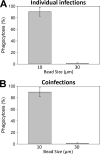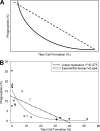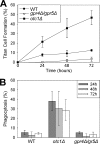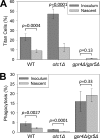Titan cells confer protection from phagocytosis in Cryptococcus neoformans infections
- PMID: 22544904
- PMCID: PMC3370461
- DOI: 10.1128/EC.00121-12
Titan cells confer protection from phagocytosis in Cryptococcus neoformans infections
Abstract
The human fungal pathogen Cryptococcus neoformans produces an enlarged "titan" cell morphology when exposed to the host pulmonary environment. Titan cells exhibit traits that promote survival in the host. Previous studies showed that titan cells are not phagocytosed and that increased titan cell production in the lungs results in reduced phagocytosis of cryptococcal cells by host immune cells. Here, the effect of titan cell production on host-pathogen interactions during early stages of pulmonary cryptococcosis was explored. The relationship between titan cell production and phagocytosis was found to be nonlinear; moderate increases in titan cell production resulted in profound decreases in phagocytosis, with significant differences occurring within the first 24 h of the infection. Not only were titan cells themselves protected from phagocytosis, but titan cell formation also conferred protection from phagocytosis to normal-size cryptococcal cells. Large particles introduced into the lungs were not phagocytosed, suggesting the large size of titan cells protects against phagocytosis. The presence of large particles was unable to protect smaller particles from phagocytosis, revealing that titan cell size alone is not sufficient to provide the observed cross-protection of normal-size cryptococcal cells. These data suggest that titan cells play a critical role in establishment of the pulmonary infection by promoting the survival of the entire population of cryptococcal cells.
Figures





Similar articles
-
Titan cell production enhances the virulence of Cryptococcus neoformans.Infect Immun. 2012 Nov;80(11):3776-85. doi: 10.1128/IAI.00507-12. Epub 2012 Aug 13. Infect Immun. 2012. PMID: 22890995 Free PMC article.
-
Cryptococcus neoformans can form titan-like cells in vitro in response to multiple signals.PLoS Pathog. 2018 May 18;14(5):e1007007. doi: 10.1371/journal.ppat.1007007. eCollection 2018 May. PLoS Pathog. 2018. PMID: 29775477 Free PMC article.
-
The formation of titan cells in Cryptococcus neoformans depends on the mouse strain and correlates with induction of Th2-type responses.Cell Microbiol. 2016 Jan;18(1):111-24. doi: 10.1111/cmi.12488. Epub 2015 Sep 6. Cell Microbiol. 2016. PMID: 26243235
-
Cryptococcal Titan Cells: When Yeast Cells Are All Grown up.Curr Top Microbiol Immunol. 2019;422:101-120. doi: 10.1007/82_2018_145. Curr Top Microbiol Immunol. 2019. PMID: 30406867 Review.
-
Catch me if you can: phagocytosis and killing avoidance by Cryptococcus neoformans.FEMS Immunol Med Microbiol. 2012 Mar;64(2):147-61. doi: 10.1111/j.1574-695X.2011.00871.x. FEMS Immunol Med Microbiol. 2012. PMID: 22029633 Review.
Cited by
-
Cryptococcal pathogenic mechanisms: a dangerous trip from the environment to the brain.Mem Inst Oswaldo Cruz. 2018;113(7):e180057. doi: 10.1590/0074-02760180057. Epub 2018 Apr 16. Mem Inst Oswaldo Cruz. 2018. PMID: 29668825 Free PMC article. Review.
-
The Cryptococcus neoformans Titan cell is an inducible and regulated morphotype underlying pathogenesis.PLoS Pathog. 2018 May 18;14(5):e1006978. doi: 10.1371/journal.ppat.1006978. eCollection 2018 May. PLoS Pathog. 2018. PMID: 29775474 Free PMC article.
-
The pathobiology of human fungal infections.Nat Rev Microbiol. 2024 Nov;22(11):687-704. doi: 10.1038/s41579-024-01062-w. Epub 2024 Jun 25. Nat Rev Microbiol. 2024. PMID: 38918447 Review.
-
Last but not yeast-The many forms of Cryptococcus neoformans.PLoS Pathog. 2023 Jan 5;19(1):e1011048. doi: 10.1371/journal.ppat.1011048. eCollection 2023 Jan. PLoS Pathog. 2023. PMID: 36602969 Free PMC article. No abstract available.
-
Animal Models of Cryptococcus neoformans in Identifying Immune Parameters Associated With Primary Infection and Reactivation of Latent Infection.Front Immunol. 2020 Sep 15;11:581750. doi: 10.3389/fimmu.2020.581750. eCollection 2020. Front Immunol. 2020. PMID: 33042164 Free PMC article. Review.
References
Publication types
MeSH terms
Grants and funding
LinkOut - more resources
Full Text Sources

